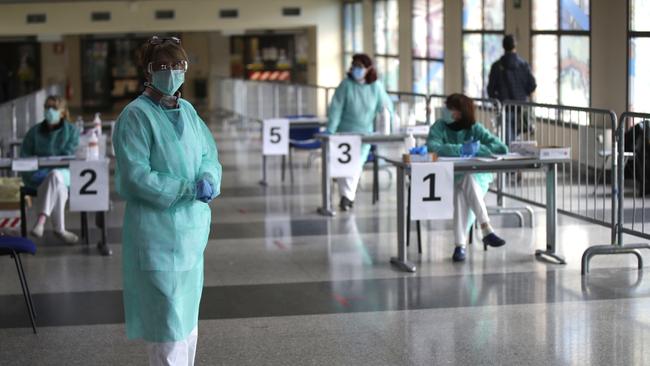Italy deaths rocket, infections of the under 50s on the rise
As Italy records its steepest increase in deaths in a day, a new study shows a growing number of those infected are aged 19-50.

New statistics from Italy, the centre of the coronavirus outbreak in Europe, have shown that while it is overwhelming and killing the very elderly, millennials, Gen X and medical workers also face a significant risk of being hospitalised.
On Wednesday, Italian authorities announced that the number of deaths from the virus is nearly 3000, after 475 people died in one day, the steepest increase yet. There are now 35,713 infections in the country.
Bergamo daily newspaper pic.twitter.com/N3ECABz8dr
— David Carretta (@davcarretta) March 14, 2020
The grim rates come as a new study finds a growing number of those infected in Italy are now aged between 19 – 50. Italy has also found that 12 per cent of people who have contracted coronavirus will require intensive care, although it is unclear if all require ventilators.
Australia is looking at the Italian experience to understand how the coronavirus might play out in the coming weeks and the news is sobering.
READ MORE: Read our COVID-19 live blog here
In a study of data from COVID-19 Task Force of the Department of Infectious Diseases and the IT Service Instituto Superiore di Sanità, scientists Edward Livingston and Karen Bucher, found young and middle aged adults should not be complacent about the risks of contracting the disease.
The study found that at the beginning of this week there were 22,512 Italians infected with coronavirus, of whom 24 per cent were aged between 19 to 50.
Those aged 51 to 70 represented 37.3 per cent of cases and those over 70 represented 37.6 per cent.
In Italy, those who are infected and in their 70s have a 12.5 per cent chance of dying; those in 80s have nearly a 20 per cent death rate; and over 90s it is 22.7 per cent. There have been no deaths in people under 30.
The study also showed that there were over 2000 infected health workers, many of them aged under 50, comprising around nine per cent of the total infections.
Italy’s national federations of doctors and nurses said it believed 2300 medical personnel have been infected, 1900 of them doctors and nurses; for which it blamed a shortage of protective masks and clothing.
The study also found seriously ill patients are also more likely to be male, at a ratio of 60:40.
Five per cent of Italian patients are classified critical, 25 per cent severe; and 46 per cent have mild symptoms and 6.7 per cent have no symptoms and another 6.7 per cent have few symptoms.
Nearly 11 per cent have unspecified symptoms.

The Italian crisis began on February 20 when a 38-year-old with no travel history to China arrived in a Lombardy hospital with respiratory distress. Within 24 hours another 36 cases were hospitalised but none of them had had contact with the first patient.
A separate scientific study conducted by three Italian doctors in the Lombardy region, showed that at the time, the region had intensive care capacity of 720 beds and within 18 days had created another 482 beds by cancelling non urgent procedures, yet they were still quickly overwhelmed.
Doctors Giacomo Grasselli, Antonio Pesenti and Maurizio Cecconi said other countries needed to learn from their efforts and that only an intensive care unit network can provide the initial immediate surge response.
“Health care systems not organised in collaborative emergency networks should work toward one now,’’ they said.
They added: “Despite prompt response of the local and regional ICU network, health authorities, and the government to try to contain the initial cluster, the surge in patients requiring ICU admission has been overwhelming.
“The proportion of ICU admissions represents 12% of the total positive cases, and 16% of all hospitalised patients. This rate is higher than what was reported from China, where only 5% of patients who tested positive for COVID-19 required ICU admission.’’
This Italian data is believed to be behind the U-turn in advice given by the Imperial College London to the British government, which had modelled the need for intensive care on a rate of five per cent. British medical and science officials said Italy’s experience and the obversation of initial British cases, showed the rate of people requiring intensive care was double that of China, prompting an effective closure of pubs, clubs and restaurants.
The Italian government ordered everyone to stay at home on March 9, to try and slow the rate of infection.
Meanwhile scientists from the National Institute of Allergy and Infectious Diseases (NIAID), part of the US National Institutes of Health, believe the virus is still able to infect people for as long as three hours after someone sneezes. They found the virus could be detected on plastic and stainless steel after three days, but on cardboard it was not viable after 24 hours.
The virus lives the shortest amount of time on copper, when it took just four hours for the virus to become inactive, they said.








To join the conversation, please log in. Don't have an account? Register
Join the conversation, you are commenting as Logout